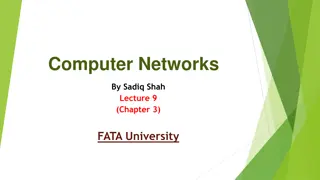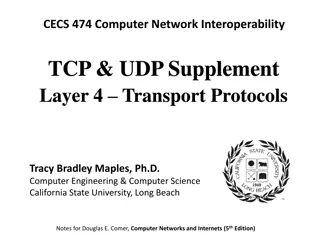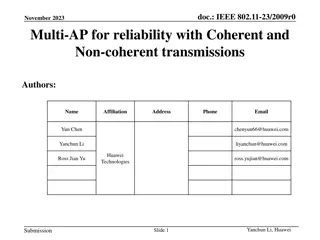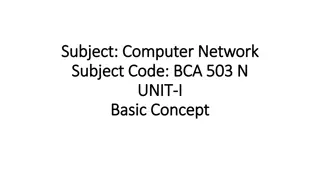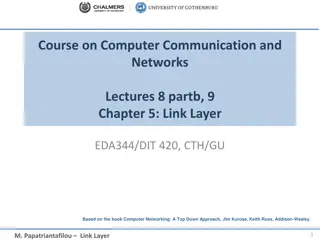Understanding Reliable Transmission in Computer Networks
Explore the essentials of reliable transmission in computer networks, including error detection methods like parity, checksums, and error-correcting codes. Learn about clock-based framing, SONET links, and synchronization techniques for data integrity. Dive into topics such as two-dimensional parity, Internet checksum algorithms, and 1's complement arithmetic. Gain insights into implementing IP checksums for network reliability.
Download Presentation

Please find below an Image/Link to download the presentation.
The content on the website is provided AS IS for your information and personal use only. It may not be sold, licensed, or shared on other websites without obtaining consent from the author. Download presentation by click this link. If you encounter any issues during the download, it is possible that the publisher has removed the file from their server.
E N D
Presentation Transcript
CPS 114: Introduction to Computer Networks Lecture 4: Reliable Transmission Xiaowei Yang xwy@cs.duke.edu
Overview Link layer functions Encoding Framing Error detection Reliable transmission
Clock-based Framing STS-1/OC-1 frame 51.840Mbps The slowest SONET link Synchronous Optical Network (SONET) A complex protocol Each frame is 125 us long, 810bytes = 125 us * 51.84Mbps 9 rows of 90 bytes each First 3 bytes are overhead First two bytes of each frame has a special pattern marking the start of a frame When the special pattern turns up in the right place enough times (every 810B), a receive concludes it s in sync.
Synchronized timeslots as placeholder Real frame data may float inside
Overview Link layer functions Encoding Framing Error detection Reliable transmission
Error detection Error detection code adds redundant information to detect errors Analogy: sending two copies of the same message Parity Checksum CRC Error correcting code: more sophisticated code that can correct errors
Two-dimensional parity A sample frame of six bytes Even parity bit Make an even number of 1s in each row and column Detect all 1,2,3-bit errors, and most 4-bit errors
Internet checksum algorithm Basic idea Add all the words transmitted and then send the sum. Receiver does the same computation and compares the sums IP checksum Adding 16-bit short integers using 1 s complement arithmetic Take 1 s complement of the result
1s complement -x is each bit of x inverted If there is a carry bit, add 1 to the sum Example: 4-bit integer -3: 1100 (invert of 0011) -4: 1011 (invert of 0100) -3 + -4 = 0111 + 1 = 1000 (invert of 0111 (-7))
IP checksum implementation (used in labs) uint16_t cksum (const void *_data, int len) { const uint8_t *data = _data; uint32_t sum; for (sum = 0;len >= 2; data += 2, len -= 2) sum += data[0] << 8 | data[1]; if (len > 0) sum += data[0] << 8; while (sum > 0xffff) sum = (sum >> 16) + (sum & 0xffff); sum = htons (~sum); return sum ? sum : 0xffff; }
Remarks Can detect 1 bit error But not all two-bits One increases the sum, and one decreases it Efficient for software implementation Needs to be done for every packet inside a router!
Cyclic Redundancy Check A branch of finite fields High-level idea: Represent an n+1-bit message with an n degree polynomial M(x) Divide the polynomial by a k-bit divisor C(x) k-bit CRC: remainder after divided by a degree-k divisor polynomial Send Message + CRC that is dividable by C(x)
Polynomial arithmetic modulo 2 B(x) can be divided by C(x) if B(x) has higher degree B(x) can be divided once by C(x) if of same degree Remainder of B(x)/C(x) = B(x) C(x) Substraction is done by XOR each pair of matching coefficients
CRC algorithm 1. Multiply M(x) by x^k. Add k zeros to Message. Call it T(x) 2. Divide T(x) by C(x) and find the remainder 3. Send P(x) = T(x) remainder Append remainder to T(x) P(x) dividable by C(x)
An example 8-bit msg 10011010 Divisor (3bit CRC) 1101
How to choose a divisor Complicated Intuition: unlikely to be divided evenly by an error Find C(x) by looking it up in a book
Hardware implementation Very efficient: XOR operations 0 to k-1 registers (k-bit shift registers) If nth (n < k) term is not zero, places an XOR gate x3 + x2 + 1
Overview Link layer functions Encoding Framing Error detection Reliable transmission
Reliable transmission What to do if a receiver detects bit errors? Two high-level approaches Forward error correction (FEC): the correction of errors handled in advance by sending Retransmission (lab 1) Acknowledgements: a small piece of control information sent back to its peer acknowledging the receipt of a frame Can be piggybacked on data packets Timeouts: if a sender does not receive an ack after some time, retransmit the original frame Also called Automatic repeat request (ARQ)
Stop-and-wait Send one frame, wait for an ack, and send the next Retransmit if times out Note in the last figure (d), there might be confusion: a new frame, or a duplicate?
Sequence number Add a sequence number to each frame to avoid the ambiguity
Stop-and-wait drawback Revisiting bandwidth-delay product Total delay/latency = transmission delay + propagation delay + queuing Queuing is the time packet sent waiting at a router s buffer Will revisit later (no sweat if you don t get it now)
Delay * bandwidth product For a 1Mbps pipe, it takes 8 seconds to transmit 1MB. If the link latency is less than 8 seconds, the pipe is full before all data are pumped into the pipe For a 1Gbps pipe, it takes 8 ms to transmit 1MB.
Stop-and-wait drawback A 1Mbps link with a 100ms two-way delay (round trip time, RTT) 1KB frame size Throughput = 1KB/ (1KB/1Mbps + 100ms) = 74Kbps << 1Mbps Delay x bandwidth = 100Kb So we could send ~12 frames before the pipe is full! Throughput = 100Kb/(1KB/1Mbps + 100ms) = 926Kbps
Sliding window Key idea: allowing multiple outstanding (unacked) frames to keep the pipe full
Sliding window on sender Assign a sequence number (SeqNum) to each frame Maintains three variables Send window size (SWS) that bounds the number of unacked frames the sender can transmit Last ack received (LAR) that denotes the sequence number of the last ACK received Last frame sent (LFS) that denotes the sequence number of the last frame sent Invariant: LFS LAR SWS
Slide window this way when an ACK arrives Sender actions When an ACK arrives, moves LAR to the right, opening the window to allow the sender to send more frames If a frame times out before an ACK arrives, retransmit
Sliding window on receiver Maintains three window variables Receive window size (RWS) that bounds the number of out-of-order frames it s willing to receive Largest acceptable frame (LAF) denotes the sequence number of that frame Last frame received (LFR) denotes the sequence number of last frame received Invariant LAF LFR RWS
When a frame with SeqNum arrives Discards it if out of window Seq LFR or Seq > LAF If in window, decides what to ACK Cumulative ack: a variable SeqNumToAck denotes the largest sequence number not acked but all frames with a sequence number smaller than it have been acked Acks SeqNumToAck even if higher-numbered packets have been received Sets LFR = SeqNumToAck, LAF = LFR + RWS Updates SeqNumToAck
Finite sequence numbers Things may go wrong when SWS=RWS, SWS too large Example 3-bit sequence number, SWS=RWS=7 Sender sends 0, , 6; receiver acks, expects (7,0, , 5), but all acks lost Sender retransmits 0, ,6; receiver thinks they are new SWS < (MaxSeqNum+1)/2 Alternates between first half and second half of sequence number space as stop-and-wait alternates between 0 and 1
Sliding window protocol (SWP) implementation typedef u_char SwpSeqno; typedef struct { SwpSeqno SeqNum; /* sequence number of this frame */ SwpSeqno AckNum; /* ack of received frame */ u_char Flags; /* up to 8 bits' worth of flags */ } SwpHdr; Your code will look very different!
typedef struct { } sendQ[SWS]; /* sender side state: */ SwpSeqno LAR; /* seqno of last ACK received */ SwpSeqno LFS; /* last frame sent */ Semaphore sendWindowNotFull; SwpHdr hdr; /* preinitialized header */ struct sendQ_slot { Event timeout; /* event associated with send-timeout */ Msg msg; } SwpState; /* receiver side state: */ SwpSeqno NFE; /* seqno of next frame expected */ struct recvQ_slot { int received; /* is msg valid? */ Msg msg; } recvQ[RWS];
static int sendSWP(SwpState *state, Msg *frame) { struct sendQ_slot *slot; hbuf[HLEN]; /* wait for send window to open */ semWait(&state->sendWindowNotFull); state->hdr.SeqNum = ++state->LFS; slot = &state->sendQ[state->hdr.SeqNum % SWS]; store_swp_hdr(state->hdr, hbuf); msgAddHdr(frame, hbuf, HLEN); msgSaveCopy(&slot->msg, frame); slot->timeout = evSchedule(swpTimeout, slot, SWP_SEND_TIMEOUT); return sendLINK(frame); }
static int deliverSWP(SwpState state, Msg *frame) { SwpHdr hdr; char *hbuf; hbuf = msgStripHdr(frame, HLEN); load_swp_hdr(&hdr, hbuf) if (hdr->Flags & FLAG_ACK_VALID) { /* received an acknowledgment---do SENDER side */ if (swpInWindow(hdr.AckNum, state->LAR + 1, state->LFS)) { do { struct sendQ_slot *slot; slot = &state->sendQ[++state->LAR % SWS]; evCancel(slot->timeout); msgDestroy(&slot->msg); semSignal(&state->sendWindowNotFull); } while (state->LAR != hdr.AckNum); } }
if (hdr.Flags & FLAG_HAS_DATA) { struct recvQ_slot *slot; /* received data packet---do RECEIVER side */ slot = &state->recvQ[hdr.SeqNum % RWS]; if (!swpInWindow(hdr.SeqNum, state->NFE, state->NFE + RWS - 1)) { /* drop the message */ return SUCCESS; } msgSaveCopy(&slot->msg, frame); slot->received = TRUE; if (hdr.SeqNum == state->NFE) { Msg m; while (slot->received) { deliverHLP(&slot->msg); msgDestroy(&slot->msg); slot->received = FALSE; slot = &state->recvQ[++state->NFE % RWS]; } /* send ACK: */ prepare_ack(&m, state->NFE - 1); sendLINK(&m); msgDestroy(&m); }} return SUCCESS; }
static bool swpInWindow(SwpSeqno seqno, SwpSeqno min, SwpSeqno max) { SwpSeqno pos, maxpos; pos = seqno - min; /* pos *should* be in range [0..MAX)*/ maxpos = max - min + 1; /* maxpos is in range [0..MAX]*/ return pos < maxpos; }
Flow control with sliding window Remark: perhaps the best-known algorithm in computer networking Multiple functions Reliable deliver frames over a link In-order delivery to upper layer protocol Flow control Not to overun a slow slower Congestion control (later) Not to congest the network
Other ACK mechanisms NACK: negative acks for packets not received unnecessary, as sender timeouts would catch this information SACK: selective ACK the received frames + No need to send duplicate packets - more complicated to implement Newer version of TCP has SACK
Conclusion A lot for today CRC Reliability FEC Stop-and-Wait Sliding window









